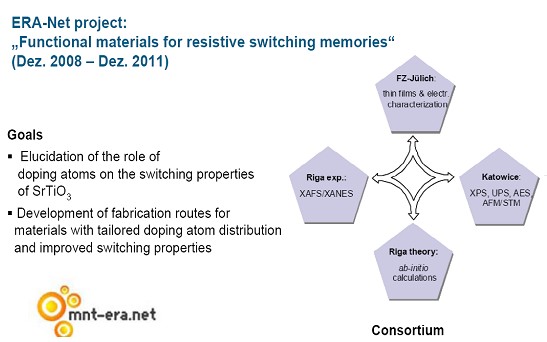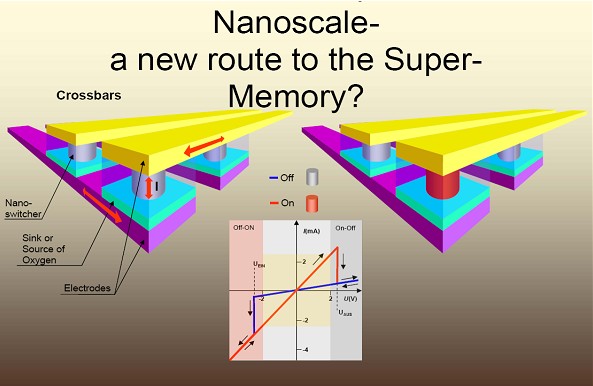Functional materials for terabit resistive switching memories
Period: January 2009-January 2012
Responsible person: J. Purans
Contact person for theoretical sub-project: E.A. Kotomin
Studies performed in J�lich with use of Local Conductivity AFM have shown that there is a clear correlation between conducting filaments and dislocations in SrTiO3 single crystals. The recent results obtained for thin films of SrTiO3 doped with Nb or Fe confirmed that a material showing resisitive switching is composed of filaments where a local metal-to-insulator transition takes place. The effect is most likely driven by a redox process within a network of extended defects, mostly dislocations. It involves motion of oxygen anions and related with this migration of oxygen vacancies.
Nevertheless the nature of switching phenomenon and the role of doping atoms is far from being understood. It causes that the developed RRAM devices based on these materials do not fulfil at the present stage requirements for future memory.
Another problem is related to electroforming process which is usually necessary prior to obtain stable switching properties. The conditions of electroforming depend strongly on material and polarization, however its nature is not clear .
The aim of the team from three countries (R. Waser, R. Dittmann, K. Szot - Research Centre J�lich, J. Purans, A.Kuzmin, E. Kotomin, ISSP-Riga, J. Szade � University of Silesia, Katowice) is to clarify the role of doping atoms in resistive switching SrTiO3 thin films and to develop the basic science and technology for new functional ternary oxides.
Starptautiskam MATERA projekta mērķis ir attīstīt fundamentālo zinātni un tehnoloģiju jauniem funkcionāliem 3-komp. oksīdiem, lai tos izmantotu kā nākotnes rezistīvās pārslēgšanās atmiņas. Kopš tādi defekti kā dislokācijas vai defektu klāsteri ar nanoskalas izmēriem tiek apskatīti kā vienkāršas rezistīvās pārslēgšanās vienības dopētos ABO3-perovskītos, mums ir jāiegūst dziļāka izpratne par komplekso saistību starp defektu struktūrām, elementāro defektu, defektu sadalījumu un pārslēgšanās īpašībām.


Projekta 1. posma „Darba uzdevumā” definētie uzdevumi:
• Eksperimentāli izpētīt XANES struktūru Fe3+ un Fe4+ punktveida defektiem SrTiO3 tilpumā. Izmantojot Rtg-staru (sinhrotrona staru) absorbcijas spektroskopiju (0-50eV).
• Teorētiski aprakstīt XANES (0-50eV) struktūru Fe3+ un Fe4+ punktveida defektiem SrTiO3 tilpumā izmantojot FEFF datoru modelēšanu.
• Eksperimentāli izpētīt EXAFS struktūru Fe3+ un Fe4+ punktveida defektiem SrTiO3 tilpumā. izmantojot Rtg-staru (sinhrotrona staru) absorbcijas spektroskopiju (50 – 1000 eV).
• Teorētiski aprakstīt EXAFS (0-50eV) struktūru Fe3+ un Fe4+ punktveida defektiem SrTiO3 tilpumā izmantojot FEFF datoru modelēšanu.
• Izmantojot liela mēroga datoru modelēšanu, veikt punktveida defektu īpašību aprēķinus SrTiO3 tilpumā.
• Izmantojot plašas skalas paralēlos datoru aprēķinus ar lielām superšūnām, aprēķināt un izanalizēt defektu veidošanās enerģijas, lokālā režģa deformāciju un lādiņa pārdalīšanos.
• Izmantojot „slāņa” modeli, veikti punktveida defektu segregācijas aprēķinus uz virsmām. Uzmanības centrā jabūt analīzei, kā defektu veidošanās enerģija izmainās (reducējas) no tilpuma uz virsmu un cik liela ir enerģijas segregācija atšķirīgiem defektu tipiem.